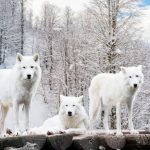In comparison to wolves, wolverines are considerably smaller and less powerful animals. They are members of the family Mustelidae.
Their heads are rounded, their legs are short, their paws are huge, and their tails are short. Their length ranges from 25 to 35 inches, and their weight ranges from 20 to 55 pounds. They resemble a smaller version of a bear and have thick fur that is greasy.

A wolf is a member of the Canidae family, which also includes dogs, and has an appearance that is comparable to that of a dog. In general, their length ranges from 40 inches to 65 inches, and their weight ranges from 40 pounds to 175 pounds.
They have a huge heads, tall torsos, long legs, and long, bushy tails. Their length ranges from 40 inches to 65 inches. They possess thick fur that can range in color from grey to black.

| Wolverine | Wolf | |
| Length | In compared to a wolf, a wolverine typically measures between 25 and 35 inches in length and is considerably smaller. | The average length of a wolf ranges from 40 to 65 inches, making it significantly longer than a wolverine. |
| Weight | A wolverine weighs somewhere between 20 and 55 pounds, making it much smaller than a wolf. | A wolf may weigh anywhere between around 40 and 175 pounds, making it far bigger than a wolverine. |
| Speed and movement | 30 miles per hour. Runs with a quick gallop | 35 miles per hour for brief periods. Uses a galloping sprint |
| Bite power and teeth | A biting force of 50 pounds per square inch. Special molars intended to shatter bones and rip meat | 400 PSI of biting force, and maybe much more out in the wild.42 pointed teethCanines measuring 2 inches in length. |
| Senses | It has poor eyesight but an excellent hearing and a powerful sense of smell, allowing it to detect prey in burrows even while it is above ground. | Keen sense of vision with front-facing eyes, like many other types of predators, giving it a powerful sense of smell. Wolves have acute hearing and can detect prey from great distances. |
| Defenses | A dense coat. A pungent odor that is known to deter some types of predators. | The comfort of knowing you are not alone in its group. The agility to get away from any threats. |
| Behavior | Can ambush from stealth. Can run down slower foes. Can hunt alone. Can salvage items | Endurance hunters that can track down their foes and wear them out with constant speed and strikes that deplete their strength |
| Lifespan | 5 to 13 year | 14 to 16 year |
- Difference between a wolverine and a wolf based on their size
In spite of the fact that it may be tempting to disregard the wolverine right away, these animals can grow to be extremely large. The largest of their wolverines may weigh as much as 70 pounds and measure as much as 3.5 feet in length. However, that is rather insignificant in comparison to a wolf. They can grow to a length of 5 feet, weigh more than 150 pounds, and stand more than 3 feet tall. The Mackenzie Valley wolf, which may be found in the northern parts of Canada and Alaska, is the biggest species of wolf.

Figure: Wolf

Figure: Wolverine
- Difference between a wolverine and wolf based on their speed and movement
When galloping, a wolverine is capable of reaching speeds of up to 30 miles per hour. They have great endurance and can run for dozens of miles without stopping, although they do not run at their maximum pace the entire time. This is an interesting trait. Wolves may reach speeds of up to 35 miles per hour during brief spurts of running.
- Difference between a wolverine and wolf based on their bite power and teeth
Wolverines are able to turn even a weak bite into a lethal strike because to their formidable set of teeth, which compels most other species to retreat once they have attacked. Even though their biting force is just 50 PSI, which is less than a dog’s, they are nevertheless able to easily break bones and pull flesh away from their prey.
The teeth of wolves and dogs are quite similar. Their canines measure 2 inches in length, and they have a biting force of 400 pounds per square inch (PSI). Their fangs allow them to rip through flesh and pierce crucial places with ease.
- Difference between a wolverine and wolf based on their senses
Wolverines have poor eyesight, but they make up for it with excellent hearing and an acute sense of smell, all of which allow them to detect their prey even when it is buried underground in tunnels.
Because of their exceptional senses of hearing, smell, and eyesight, wolves are ideally suited for tracking down their prey.
- Difference between a wolverine and wolf based on their defense
Wolverines are equipped with a coarse coat and the ability to secrete a putrid scent that may either frighten away or paralyze some types of potential prey.
The defence of wolves are not particularly advanced. In point of fact, the majority of their advantages come from their speed and the habit of travelling in packs.
- Difference between a wolverine and wolf based on their habitat
The wolverine is a type of scavenger known as a facultative scavenger, which indicates that it is a scavenger, but it is also capable of hunting and eating its prey if it cannot find any leftover food. In most cases, they consist of tiny creatures such as porcupines, rabbits, beavers, and so forth.
A wolf is a carnivore that typically hunts wild animals such as deer, caribous, wild goats, wild sheep, and elk, among other prey species.
- Difference between a wolverine and wolf based on their lifespan
Seven years is the typical amount of time a wolverine spends in the wild. Those who are kept as captives have been known to survive for up to 18 years.
In the wild, wolves have a maximum lifespan of 14 years, but those kept as pets have a maximum lifespan of 16 years.
Do Wolverines Mate and Stay Pregnant for the Same Length of Time as Lions?
Wolverines have a distinct reproduction style compared to lions. While lion pregnancy duration and mating frequency are well-documented, wolverines have an average gestation period of 30 to 50 days. Additionally, wolverines can mate throughout the year, whereas lions have specific mating seasons. This highlights the contrasting reproductive behaviors between these two species.
Conclusion
Both wolves and wolverines are members of the carnivore order, and they are the biggest members of their respective canid families.
Because their names are similar, it is easy to believe that they are connected in some way, but in reality, they belong to completely distinct species and have a great deal in common with one another. Wolves are members of the family Canidae. They are larger, more powerful, and swifter than wolverines.
Wolves always live in groups known as packs and consume their food together. Wolves, in contrast to wolverines, have specific physical characteristics that set them apart from one another.
Wolverines have thick, oily fur, rounded skulls, and an appearance that is similar to that of a tiny bear. They like hunting and feeding on dead and decaying leftovers, therefore you will most often find them in cooler environments.
They are not as powerful as wolves, and as a result, such animals can kill them. They are considered solitary creatures because they do not dwell in groups.






